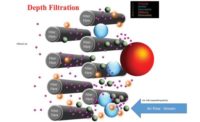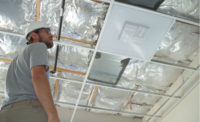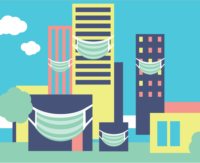The recent pandemic revealed the deficiency of conventional air filters and the inability of yesterday's HVAC systems to protect the well-being of human occupants. Who said air conditioning refers to only heat transfer and moisture control? Who could argue the conditioning function should not entail removing all pollutants that become a potential hazard to human occupants? Who could imply or state that the limited spaces assigned to the air filters in HVAC units carry a hidden message about the importance of air quality?


The trouble started years ago, when filtration experts addressed the air quality initiatives, and decision-makers decided to leave rather than lead the conversation, debunking filtration myths, allocating insufficient budgets, and employing inappropriate technologies in an attempt to make a difference. As a result, air quality has been dismissed from building design and maintenance plans. For decades, air filtration has been waiting for its seat at the HVAC table, given its bearing on indoor comfort. But, unfortunately, the focus of facility management hovered only around thermal comfort, energy efficiency, cutting costs, and maximizing revenues. Consequently, global governments chose to flee through curfews and lockdowns rather than fight when the coronavirus crossed borders and settled into cities.

Why did facemasks soar as other air filtration technologies struggled to make their way into HVAC system? As the pandemic wanes, both have been delisted from modern-day priorities. The yawning disparity between the demand for enhanced IAQ and filter performance reflects the technological gaps roiling the industry. Should COVID-19 have been the speed bump that made us fix the entire air quality vehicle? Should the pandemic have been a pop quiz that would prepare us for the final climate change exam?
The bureaucracies of filter upgrades and the anemic growth of HVAC technologies have proven that air quality deterioration is almost insurmountable in the era of conventional maintenance practices. Globally, the business model of facility management kept outdated maintenance philosophies afloat by:
- Reusing disposable filters;
- Disconnecting pressure gauges;
- Subsidizing reactive measures, such as coil and ducting cleaning;
- Focusing on cutting costs and maximizing revenues only; and
- Thwarting filter upgrades and air quality enhancements.


How can facility managers feel the heat when they direct, from their comfortable offices, their maintenance teams and continue to overlook the minimum wages and poor working and climate conditions? Equally important is the disregard some employers have for the lack of appropriate tools needed by maintenance teams to properly complete their jobs, for example, when their employers claim that an inch filter with a 2-inch leak will render indoor environment safe. (see Figure 4).

Inappropriate filter design, media selection, and the attempts to regenerate disposable filters with water and air for reuse in air-handling units (AHUs) have become standard practice. The misconception that drives these practices lies in the myth of extending the filter's lifetime and, hence, saving costs. The dismissal of maintenance mishaps, chronic filter failures, the insufficient filtration stages, poor filter performance, leaky installations, and the refusal to acknowledge signs and symptoms of poor air quality have contributed to the deterioration of IAQ. Nevertheless, while designers, regulators, and decision-makers of the built environment may have had myopia, air quality remains the foundation of indoor comfort and a pillar of our local, regional, and global economies.


Although granting air quality due attention is congruent with common sense, we cannot achieve our goals if we rely solely on moral forces, particularly when maintenance teams practice what they should not be preaching. The pandemic has brutally provided the epiphany in emphasizing that providing sustainable indoor environment is a social responsibility, which should not be mutually exclusive with making profits.

The "Challenge and Change" Initiative
Before engineers demand change in HVAC maintenance, air filtration, and any practice that would give rise to IAQ, they ought to be clear about the scale, speed, and scope of change they aspire to. Furthermore, the industry needs evolutionary — not revolutionary — methods and means to envision accurate descriptions of how change can come about and develop. Frequent filter replacement is not the only answer for air quality enhancement. It must be accompanied by a thorough physical and chemical characterization of airborne pollutants to employ appropriate air filtration technologies to combat them. Furthermore, the deployment of air quality sensors infrastructure to track, detect, and acquire real-time data for the HVAC system to respond to air quality variation instantaneously is essential to render the built environment safe to occupy.
Finally, maintenance attitudes should shift toward enhancing air quality and employing appropriate air filtration technologies. It is ironic how some facility managers can sometimes be wrong and strong in embracing the theology of tricks and shortcuts. Raising the bar of air quality in the built environment should be embedded in its standards of living and not based on demand. It is time to challenge the status quo and change how engineers approach air quality and the associated technologies serving human occupants. Globally, governments can facilitate that change by investing in air filtration technologies, increasing funds directed to research, replacing or retrofitting aged HVAC systems, and remaking existing cities to embrace sustainable living. The "Challenge and Change" initiative includes other elements but is not limited to:
- Certifying filtration solutions, not just products.
- Qualifying installers and maintenance technicians through training and retraining programs to equip them with the appropriate tools and latest technologies available in the market. We must admit they are our boots on the ground, and equipping them with modest safety shoes and screwdrivers does not make them ready, willing, or capable of getting the job done, given the abrasive ambient and working conditions they have to sustain.
- Legislating laws that insist on continuous air quality monitoring outdoors and indoors. Furthermore, legally binding responsible maintenance-in-charge parties to monitor and verify air filter performance. Regulating and rewarding all aspects of the HVAC system through enshrining laws and establishing “air quality centers of excellence,” where academic institutions can capitalize on research and development funds to take air quality to the next level. On the other hand, the private sector and industry leaders can contribute to such a movement by making air quality measurement affordable and available to a wide array of users worldwide.
- Avoiding any practices that may accelerate facility and HVAC equipment aging. Ultimately, the premise here is to question not only the age of the HVAC systems that would cripple air quality enhancements but also the age of school of thought-leading facility management.


The Value and Purpose of Air Filtration
We miscalculate the cost by equating price to value. Decision-makers appreciate the value of air filtration and its role in separating and retaining various airborne pollutants from the airstream. However, doing so overlooks the intended purpose of filtering air and the associated intellectual properties, technological expertise, research, and development investments. We reinforce the view that filter testing, quality, and performance are peripheral to filter selection criteria. We, thus, bluntly declare that such critical factors are on the wrong side of our balance sheet. There is a massive gap between rhetoric and actions regarding appropriate filter selection, installation, and performance. Indoor and outdoor air quality monitoring can be a game-changer as far as what our lungs inhale and what filters air handling should encapsulate to enhance the health and safety of human occupants.

The Global Response
Unless global governments insist on adherence to second-to-none regulations and testing standards that protect the indoor environment and its human occupants, enhancing IAQ will not be fully implemented. Over the past few decades, humanity has spent more time dancing around improving air quality and taking less action. Indeed, humans need to alter how they live and consume the planet's finite resources. Globally, most economies are fossil fuel-based, and their emissions contribute to the degradation of outdoor air quality. Without strict government emissions regulations and incentive programs to raise the bar of outdoor and indoor air quality, the rising tide of air pollution will have early and well-pronounced effects on public health globally as it has already impacted climate change.
Preaching the Air Quality Promise
Many air quality and filtration experts believed the pandemic would promise better air quality. However, engineers cannot go far with air quality if existing political institutions move slowly, even if they are well-intentioned. Although many global voices demand international cooperation to make air quality a global priority, logistics, actions, and outcomes have not lived up to the expectations and the nature of change the planet strives for. The business models of capitalism that drive global economies typically reward those leaders for maximizing the bottom line and short-term profits, not addressing major environmental, social, and governance (ESG) issues. On every occasion where leaders intend and insist on making a difference on the pressing issues facing humanity, the argument emerges that success on a global scale takes time. Unfortunately, the pandemic swallowed any time that remained.
Smart Is Clean and Green
Although the environmental challenges before us are grand, the current situation represents a historic calling to sink or swim by bending the arc of waste in resources, energy, materials, and even human potential toward a sustainable future. COVID-19 is not precisely the Spanish flu, and this isn't 1918. Humanity is now far more equipped to make a difference faster than ever. However, it is not enough to speak the sustainability language; humanity needs to be on the same action page. Let humanity gird for a marathon, not a sprint, as existence aims to solve outdoor and indoor air challenges. Humans' actions have wounded the planet for decades rather than contributing to its bio-generation. Settling for imperfect compromises and experiences are expected, but efforts to advance the cause must eventually converge as time is, undoubtedly, of the essence. What would our world be like if smart cities had built environments filtered professionally through a responsive HVAC system that acted immediately to any changes in IAQ? The time for action is now through a purpose that is consciencely heard, equally shared, and professionally served.





